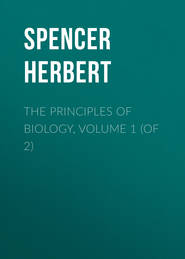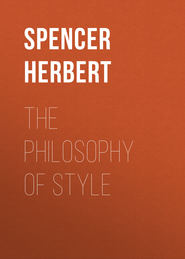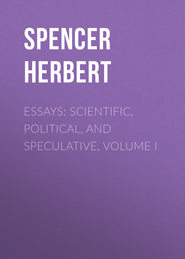По всем вопросам обращайтесь на: info@litportal.ru
(©) 2003-2024.
✖
Illustrations of Universal Progress: A Series of Discussions
Настройки чтения
Размер шрифта
Высота строк
Поля
Of the alleged connexion between inorganic forms and the wholly irregular and the castellated styles of building, we have, I think, some proof in the fact that when an edifice is irregular, the more irregular it is the more it pleases us. I see no way of accounting for this fact, save by supposing that the greater the irregularity the more strongly are we reminded of the inorganic forms typified, and the more vividly are aroused the agreeable ideas of rugged and romantic scenery associated with those forms.
Further evidence of these several relationships of styles of architecture to classes of natural objects, is supplied by the kinds of decoration they respectively represent. The public buildings of Greece, while characterized in their outlines by the bilateral symmetry seen in the higher animals, have their pediments and entablatures covered with sculptured men and beasts. Egyptian temples and Assyrian palaces, while similarly symmetrical in their general plan, are similarly ornamented on their walls and at their doors. In Gothic, again, with its grove-like ranges of clustered columns, we find rich foliated ornaments abundantly employed. And accompanying the totally irregular, inorganic outlines of old castles, we see neither vegetable nor animal decorations. The bare, rock-like walls are surmounted by battlements, consisting of almost plain blocks, which remind us of the projections on the edge of a rugged cliff.
But perhaps the most significant fact is the harmony that may be observed between each type of architecture and the scenes in which it is indigenous. For what is the explanation of this harmony, unless it be that the predominant character of surrounding things has, in some way, determined the mode of building adopted?
That the harmony exists is clear. Equally in the cases of Egypt, Assyria, Greece, and Rome, town life preceded the construction of the symmetrical buildings that have come down to us. And town life is one in which, as already observed, the majority of familiar objects are symmetrical. We instinctively feel the naturalness of this association. Out amid the fields, a formal house, with a central door flanked by an equal number of windows to right and left, strikes us as unrural – looks as though transplanted from a street; and we cannot look at one of those stuccoed villas, with mock windows carefully arranged to balance the real ones, without being reminded of the suburban residence of a retired tradesman.
In styles indigenous in the country, we not only find the general irregularity characteristic of surrounding things, but we may trace some kinship between each kind of irregularity and the local circumstances. We see the broken rocky masses amid which castles are commonly placed, mirrored in their stern, inorganic forms. In abbeys, and such-like buildings, which are commonly found in comparatively sheltered districts, we find no such violent dislocations of masses and outlines; and the nakedness appropriate to the fortress is replaced by decorations reflecting the neighbouring woods. Between a Swiss cottage and a Swiss view there is an evident relationship. The angular roof, so bold and so disproportionately large when compared to other roofs, reminds one of the adjacent mountain peaks; and the broad overhanging eaves have a sweep and inclination like those of the lower branches of a pine tree. Consider, too, the apparent kinship between the flat roofs that prevail in Eastern cities, interspersed with occasional minarets, and the plains that commonly surround them, dotted here and there by palm trees. You cannot contemplate a picture of one of these places, without being struck by the predominance of horizontal lines, and their harmony with the wide stretch of the landscape.
That the congruity here pointed out should hold in every case must not be expected. The Pyramids, for example, do not seem to come under this generalization. Their repeated horizontal lines do indeed conform to the flatness of the neighbouring desert; but their general contour seems to have no adjacent analogue. Considering, however, that migrating races, carrying their architectural systems with them, would naturally produce buildings having no relationship to their new localities; and that it is not always possible to distinguish styles which are indigenous, from those which are naturalized; numerous anomalies must be looked for.
The general idea above illustrated will perhaps be somewhat misinterpreted. Possibly some will take the proposition to be that men intentionally gave to their buildings the leading characteristics of neighbouring objects. But this is not what is meant. I do not suppose that they did so in times past, any more than they do so now. The hypothesis is, that in their choice of forms men are unconsciously influenced by the forms encircling them. That flat-roofed, symmetrical architecture should have originated in the East, among pastoral tribes surrounded by their herds and by wide plains, seems to imply that the builders were swayed by the horizontality and symmetry to which they were habituated. And the harmony which we have found to exist in other cases between indigenous styles and their localities, implies the general action of like influences. Indeed, on considering the matter psychologically, I do not see how it could well be otherwise. For as all conceptions must be made up of images, and parts of images, received through the senses – as it is impossible for a man to conceive any design save one of which the elements have come into his mind from without; and as his imagination will most readily run in the direction of his habitual perceptions; it follows, almost necessarily, that the characteristic which predominates in these habitual perceptions must impress itself on his design.
XIII.
THE USE OF ANTHROPOMORPHISM
That long fit of indignation which seizes all generous natures when in youth they begin contemplating human affairs, having fairly spent itself, there slowly grows up a perception that the institutions, beliefs, and forms so vehemently condemned are not wholly bad. This reaction runs to various lengths. In some, merely to a comparative contentment with the arrangements under which they live. In others to a recognition of the fitness that exists between each people and its government, tyrannical as that may be. In some, again, to the conviction, that hateful though it is to us, and injurious as it would be now, slavery was once beneficial – was one of the necessary phases of human progress. Again, in others, to the suspicion that great benefit has indirectly arisen from the perpetual warfare of past times; insuring as this did the spread of the strongest races, and so providing good raw material for civilization. And in a few this reaction ends in the generalization that all modes of human thought and action subserve, in the times and places in which they occur, some useful function: that though bad in the abstract, they are relatively good – are the best which the then existing conditions admit of.
A startling conclusion to which this faith in the essential beneficence of things commits us, is that the religious creeds through which mankind successively pass, are, during the eras in which they are severally held, the best that could be held; and that this is true, not only of the latest and most refined creeds, but of all, even to the earliest and most gross. Those who regard men's faiths as given to them from without – as having origins either directly divine or diabolical, and who, considering their own as the sole example of the one, class all the rest under the other, will think this a very shocking opinion. I can imagine, too, that many of those who have abandoned current theologies, and now regard religions as so many natural products of human nature – men who, having lost that antagonism towards their old creed which they felt while shaking themselves free from it, can now see that it was highly beneficial to past generations, and is beneficial still to a large part of mankind; – I can imagine even these hardly prepared to admit that all religions, down to the lowest Fetichism, have, in their places, fulfilled useful functions. If such, however, will consistently develop their ideas, they will find this inference involved.
For if it be true that humanity in its corporate as well as in its individual aspect, is a growth and not a manufacture, it is obvious that during each phase men's theologies, as well as their political and social arrangements, must be determined into such forms as the conditions require. In the one case as in the other, by a tentative process, things from time to time re-settle themselves in a way that best consists with national equilibrium. As out of plots and the struggles of chieftains, it continually results that the strongest gets to the top, and by virtue of his proved superiority ensures a period of quiet, and gives society time to grow; as out of incidental expedients there periodically arise new divisions of labour, which get permanently established only by serving men's wants better than the previous arrangements did; so, the creed which each period evolves is one more in conformity with the needs of the time than the creed which preceded it. Not to rest in general statements, however, let us consider why this must be so. Let us see whether, in the genesis of men's ideas of deity, there is not involved a necessity to conceive of deity under the aspect most influential with them.
It is now generally admitted that a more or less idealized humanity is the form which every conception of a personal God must take. Anthropomorphism is an inevitable result of the laws of thought. We cannot take a step towards constructing an idea of God without the ascription of human attributes. We cannot even speak of a divine will without assimilating the divine nature to our own; for we know nothing of volition save as a property of our own minds.
While this anthropomorphic tendency, or rather necessity, is manifested by themselves with sufficient grossness – a grossness that is offensive to those more advanced – Christians are indignant at the still grosser manifestations of it seen among uncivilized men. Certainly, such conceptions as those of some Polynesians, who believe that their gods feed on the souls of the dead, or as those of the Greeks, who ascribed to the personages of their Pantheon every vice, from domestic cannibalism downward, are repulsive enough. But if, ceasing to regard these notions from the outside, we more philosophically regard them from the inside – if we consider how they looked to believers, and observe the relationships they bore to the natures and needs of such; we shall begin to think of them with some tolerance. The question to be answered is, whether these beliefs were beneficent in their effects on those who held them; not whether they would be beneficent for us, or for perfect men; and to this question the answer must be that while absolutely bad, they were relatively good.
For is it not obvious that the savage man will be most effectually controlled by his fears of a savage deity? Must it not happen, that if his nature requires great restraint, the supposed consequences of transgression, to be a check upon him, must be proportionately terrible; and for these to be proportionately terrible, must not his god be conceived as proportionately cruel and revengeful? Is it not well that the treacherous, thievish, lying Hindoo should believe in a hell where the wicked are boiled in cauldrons, rolled down mountains bristling with knives, and sawn asunder between flaming iron posts? And that there may be provided such a hell, is it not needful that he should believe in a divinity delighting in human immolations and the self-torture of fakirs? Does it not seem clear that during the earlier ages in Christendom, when men's feelings were so hard that a holy father could describe one of the delights of heaven to be the contemplation of the torments of the damned – does it not seem clear that while the general nature was so unsympathetic, there needed, to keep men in order, all the prospective tortures described by Dante, and a deity implacable enough to inflict them?
And if, as we thus see, it is well for the savage man to believe in a savage god, then we may also see the great usefulness of this anthropomorphic tendency; or, as before said, necessity. We have in it another illustration of that essential beneficence of things visible everywhere throughout nature. From this inability under which we labour to conceive of a deity save as some idealization of ourselves, it inevitably results that in each age, among each people, and to a great extent in each individual, there must arise just that conception of deity best adapted to the needs of the case. If, being violent and bloodthirsty, the nature be one calling for stringent control, it evolves the idea of a ruler still more violent and bloodthirsty, and fitted to afford this control. When, by ages of social discipline, the nature has been partially humanized, and the degree of restraint required has become less, the diabolical characteristics before ascribed to the deity cease to be so predominant in the conception of him. And gradually, as all need for restraint disappears, this conception approximates towards that of a purely beneficent necessity. Thus, man's constitution is in this, as in other respects, self-adjusting, self-balancing. The mind itself evolves a compensating check to its own movements; varying always in proportion to the requirement. Its centrifugal and its centripetal forces are necessarily in correspondence, because the one generates the other. And so we find that the forms of both religious and secular rule follow the same law. As an ill-controlled national character produces a despotic terrestrial government, so also does it produce a despotic celestial government – the one acting through the senses, the other through the imagination; and in the converse case the same relationship holds good.
Organic as this relationship is in its origin, no artificial interference can permanently affect it. Whatever perturbations an external agency may seem to produce, they are soon neutralized in fact, if not in appearance. I was recently struck with this in reading a missionary account of the "gracious visitations of the Holy Spirit at Vewa," one of the Feejee islands. Describing a "penitent meeting," the account says: —
"Certainly the feelings of the Vewa people were not ordinary. They literally roared for hours together for the disquietude of their souls. This frequently terminated in fainting from exhaustion, which was the only respite some of them had till they found peace. They no sooner recovered their consciousness than they prayed themselves first into an agony, then again into a state of entire insensibility."
Now these Feejee islanders are the most savage of all the uncivilized races. They are given to cannibalism, infanticide, and human sacrifices; they are so bloodthirsty and so treacherous, that members of the same family dare not trust each other; and, in harmony with these characteristics, they have for their aboriginal god, a serpent. Is it not clear then, that these violent emotions which the missionaries describe, these terrors and agonies of despair which they rejoiced over, were nothing but the worship of the old god under a new name? Is it not clear that these Feejees had simply understood those parts of the Christian creed which agree in spirit with their own – the vengeance, the perpetual torments, the diabolism of it; that these, harmonizing with their natural conceptions of divine rule, were realized by them with extreme vividness; and that the extremity of the fear which made them "literally roar for hours together," arose from the fact that while they could fully take in and believe the punitive element, the merciful one was beyond their comprehension? This is the obvious inference. And it carries with it the further one, that in essence their new belief was merely their old one under a new form – the same substantial conception with a different history and different names.
However great, therefore, may be the seeming change adventitiously produced in a people's religion, the anthropomorphic tendency prevents it from being other than a superficial change – insures such modifications of the new religion as to give it all the potency of the old one – obscures whatever higher elements there may be in it until the people have reached the capability of being acted upon by them: and so, re-establishes the equilibrium between the impulses and the control they need. If any one requires detailed illustrations of this, he will find them in abundance in the history of the modifications of Christianity throughout Europe.
Ceasing then to regard heathen theologies from the personal point of view, and considering them solely with reference to the function they fulfil where they are indigenous, we must recognise them in common with all theologies, as good for their time and places; and this mental necessity which disables us from conceiving a deity save as some idealization of ourselves, we must recognise as the agency by which harmony is produced and maintained between every phase of human character and its religious creed.
THE END
notes
1
For detailed proof of these assertions see essay on Manners and Fashion.
2
A correlative truth which ought also to be taken into account (that the state of homogeneity is one of unstable equilibrium), but which it would greatly encumber the argument to exemplify in connection with the above, will be found developed in the essay on Transcendental Physiology.
3
The idea that the Nebular Hypothesis has been disproved because what were thought to be existing nebulæ have been resolved into clusters of stars is almost beneath notice. A priori it was highly improbable, if not impossible, that nebulous masses should still remain uncondensed, while others have been condensed millions of years ago.
4
"Personal Narrative of the Origin of the Caoutchouc, or India-Rubber Manufacture in England." By Thomas Hancock.
5
This was written before moustaches and beards had become common.
6
It is somewhat curious that the author of "The Plurality of Worlds," with quite other aims, should have persuaded himself into similar conclusions.
7
For numerous illustrations see essay on "The Origin and Function of Music."
8
Those who seek information on this point may find it in an interesting tract by Mr. Alexander Bain, on Animal Instinct and Intelligence.
9
Cosmos. (Seventh Edition.) Vol. i. pp. 79, 80.
10
Any objection made to the extreme tenuity this involves, is met by the calculation of Newton, who proved that were a spherical inch of air removed four thousand miles from the Earth, it would expand into a sphere more than filling the orbit of Saturn.
11
It is alike remarkable and suggestive, that a parallel relation exists between the distribution of nebulæ and the axis of our galaxy. Just as comets are abundant around the poles of our Solar System, and rare in the neighbourhood of its plane: so are nebulæ abundant around the poles of our sidereal system, and rare in the neighbourhood of its plane.
12
It is true that, as expressed by him, these propositions of Laplace are not all beyond dispute. An astronomer of the highest authority, who has favoured me with some criticisms on this essay, alleges that instead of a nebulous ring rupturing at one point, and collapsing into a single mass, "all probability would be in favour of its breaking up into many masses." This alternative result certainly seems to be more likely. But granting that a nebulous ring would break up into many masses, it may still be contended that, since the chances are infinity to one against these being of equal sizes and equidistant, they could not remain evenly distributed round their orbit: this annular chain of gaseous masses would break up into groups of masses; these groups would eventually aggregate into larger groups; and the final result would be the formation of a single mass. I have put the question to an astronomer scarcely second in authority to the one above referred to, and he agrees that this would probably be the process.
13
Since this essay was published, the data of the above calculations have been changed by the discovery that the Sun's distance is three millions of miles less than was supposed. Hence results a diminution in his estimated mass, and in the masses of the planets (except the Earth and Moon). No revised estimate of the masses having yet been published, the table is re-printed in its original form. The diminution of the masses to the alleged extent of about one-tenth, does not essentially alter the relations above pointed out.
14











